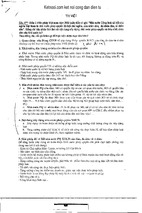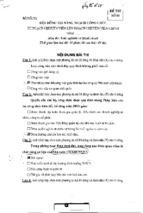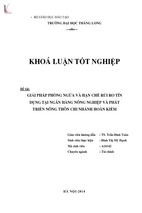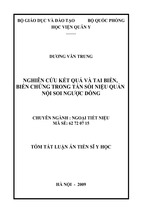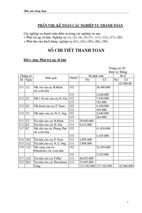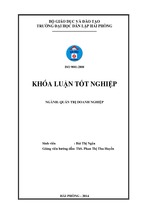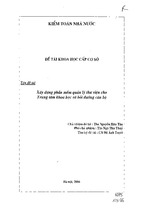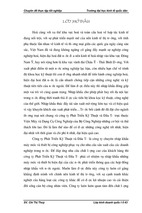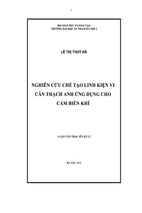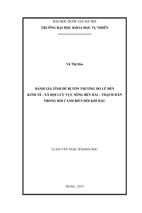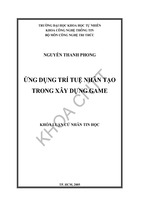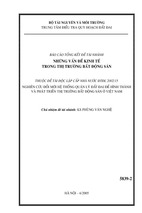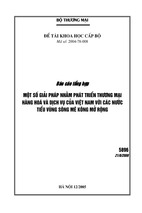Report for the Conservation Finance Alliance
National REDD+
REDD+ funding frameworks and
achieving REDD+ readiness – findings from
consultation
Contents
Acknowledgements
1
Authors
1
Glossary of terms
2
Executive summary
4
Background to the report
10
Our approach
12
REDD+ national funding flows in 2012 & 2015
13
Brazil
16
1.
2.
3.
4.
5.
Background on Brazil and REDD+
Current REDD+ funding in Brazil
Potential barriers to funding future REDD+ activity at scale
Making REDD+ a success in Brazil
Conclusions and suggested next steps
17
23
33
37
38
Cambodia
42
1.
2.
3.
4.
5.
43
47
53
55
58
Background on Cambodia and REDD+
Current REDD+ funding in Cambodia
Potential barriers to funding future REDD+ activity at scale
Making REDD+ a success in Cambodia
Conclusions and suggested next steps
DRC
1.
2.
3.
4.
5.
62
Background on DRC and REDD+
Current REDD+ funding in DRC
Potential barriers to funding future REDD+ activity at scale
Making REDD+ a success in DRC
Conclusions and suggested next steps
63
67
73
76
78
Indonesia
81
1.
2.
3.
4.
5.
82
85
90
94
97
Background on Indonesia and REDD
Current REDD+ funding in Indonesia
Potential barriers to funding future REDD+ activity at scale
Making REDD+ a success in Indonesia
Conclusions and suggested next steps
Madagascar
101
1.
102
Background on Madagascar and REDD
Report for the Conservation Finance Alliance
PricewaterhouseCoopers
Contents
2.
3.
4.
5.
Current REDD+ funding in Madagascar
Potential barriers to funding future REDD+ activity at scale.
Making REDD+ a success in Madagascar
Conclusion and suggested next steps
Peru
1.
2.
3.
4.
5.
105
111
113
115
118
Background on Peru and REDD
Current REDD+ funding in Peru
Potential barriers to funding future REDD+ activity at scale
Making REDD+ a success in Peru
Conclusions and suggested next steps
119
122
127
130
134
High level case study countries: The role of environmental funds and civil society organisations in
REDD+
138
Introduction
Recommendations for the future roles of environmental funds and NGOs in REDD+
Results
Report for the Conservation Finance Alliance
PricewaterhouseCoopers
139
142
144
Contents
Important notice
This report should be considered as an analysis of stakeholder views and publicly available data as gathered through the
research and not as a reflection of the views of Conservation Finance Alliance or member firms of the
PricewaterhouseCoopers global network. It does not constitute professional advice and you should not act upon the
information contained in this report without obtaining specific professional advice. No representation or warranty (express
or implied) is given as to the accuracy or completeness of the information contained in this report, and, to the extent
permitted by law, the Conservation Finance Alliance and PricewaterhouseCoopers do not accept or assume any liability,
responsibility or duty of care for any consequences of you or anyone else acting, or refraining to act, in reliance on the
information contained in this publication or for any decision based on it. This report does not propose optimal routes for
national fund management and disbursal, nor does it provide an exhaustive analysis of national REDD funding flows.
Report for the Conservation Finance Alliance
PricewaterhouseCoopers
Contents
Acknowledgements
The CFA and PwC would like to thank the following organisations who kindly participated in the interviews that form
the basis of this report:
ACCA – Asociación para la Conservación de la Cuenca
Amazónica
Acre REDD Plan Task Force
ADM Capital Foundation
Arias & Munoz
Australian Embassy, Indonesia
AzzeroCO2
Biofílica Investimentos Ambientais
BNDES - Banco Nacional de Desenvolvimento Econômico e
Social
Burung Indonesia
Cambodia Forest Administration
Celis Aguilar Alvarez y Asociados, S.C.
Consejo Civil Mexicano para la Silvicultura Sostenible (CCMSS)
Conservation International
Consortium - Rodríguez, Archila, Castellanos, Solares & Aguilar,
S.C.
EAMCEF - Eastern Arc Mountains Conservation Endowment
Fund
Funbio - Brazilian B
Biodiversity
iodiversity Fund
Fundação Amazonas Sustentável
Instituto de Política Ambiental (IPA)
KEHATI - Yayasan Keanekaragaman Hayati
Ludovino Lopes Advogados
Melinda Janki
Ministry of Environment, Colombia
Ministry of Environment, Indonesia
Ministry of Forestry, Ma
Madagascar
dagascar
Ministry of Forestry, Indonesia
National Climate Change Council, Indonesia
National office for the Environment – REDD technical committee,
Madagascar
New Forests Asia
Novacel
ONF International
PACT International
Philippine Tropical Forest Conservation Foundation
Pinheiro Neto Advogados
PROFAFOR S.A.
ProAves/EcoTurs
PROFONANPE-Fund
PROFONANPEFund for the Promotion of Protected Natural
Areas, Peru
Pronatura Mexico
Red RISAS/ Ecodecision
REDD National Coordination, DRC
Regional Center for People and Forests
SPDA - Peruvian Society of Environmental Rights
SFM Americas (not based in Peru, but they have REDD
agreements in Peru)
SGS
SNV International
Tanzania Forest Conservation Group
Terra Global Capital
Tozzini Freire
Tropenbos International
Uganda Carbon Bureau
Bure
U.S. Agency for International Development (USAID) –
Colombia
U.S. Agency for International Development (USAID) – Brazil
Voluntary Carbon Standard Association (VCSA)
Wildlife Conservation Society Cambodia
Wildlife Conservation Society Uganda
WWF Brazil
WWF Indonesia
WWF Central Africa Regional Programme Office (CARPO)
WWF Madagascar
WWF Mexico
WWF Peru
WWF Tanzania
The Zoological Society of London (ZSL)
The CFA would like to thank its members for their ongoing support. This report is jointly funded by: the Gordon and
Betty Moore Foundation; the Atlantic Forest Conservation Fund – AFCoF, co--financed
financed by the Federal Republic of
Germany through the Kreditanstalt für Wiederaufbau bank (KfW) and managed by Funbio; and by Conservation
International. This work is also made possible by the generous support of the American people through the United
States Agency for International Development (USAID) under the conditions of the TransLinks Leader with Associates
Cooperative Agreement, No.EPP-A-00-06
No.EPP
06-00014-00
00 to the Wildlife Conservation Society (WCS). The contents of this
work are the responsibility of the author(s) and do not necessarily represent the views of USAID or the United States
Government.
Authors
Lead authors
Chris Knight
[email protected]
+44 7841 562212
Jim Stephenson
[email protected]
+44 7828 189518
Contributing authors
Chris Webb
[email protected]
+44 7725 041949
Lanchanie Gunawardena
[email protected]
+44 7532 098760
PwC country co-authors
PwC Brazil
Leonardo Costa
[email protected]
+55 (11) 3674-3368
Marta Braconi
[email protected]
+55 (11) 3674-2000
PwC Madagascar
Liliane Raserijaona
[email protected]
+261 20 22 217 63
Domohina Ravelojaona
[email protected]
+261 20 22 217 63
PwC Peru
Carlos Delgado
[email protected]
+ 511- 2116500
Nicolas Oberrath
[email protected]
+ 511- 2116500
About PricewaterhouseCoopers (PwC)
PwC provides advisory support to conservation organisations,
multi-lateral institutions and government agencies in the
development of conservation finance and biodiversity and
ecosystem service markets. We have a deep understanding of
policy developments and market trends, strong relationships
with policymakers, experience advising on institutional, legal and
financial arrangements for ecosystem service market
mechanisms, and a track record of diverse thought leadership.
www.pwc.com/sustainability
About the Conservation Finance Alliance
PwC Gabon (DRC report)
Lindsey Domingo
[email protected]
+241 741388/741383
Baraka Kabemba
[email protected]
+241 762371/762618
PwC Indonesia
Anthony Anderson
[email protected]. com
+62 21 52890642
Simon McKenna
[email protected]
+62 21 52890645
The Conservation Finance Alliance (CFA) is a collaborative
network created in 2002 to address the challenges of
sustainable financing for conservation. Governments,
multilateral agencies, NGOs, private companies, academic
institutions and independent experts cooperate in the CFA to
promote conservation finance solutions. Currently with more
than 90 members from 40 countries, the CFA contributes to the
exchange of knowledge and best practices in conservation
finance issues. The CFA acts through Working Groups that carry
out meetings, research, publications and workshops. This report
is fruit of the collaboration of the members of the CFA
Environmental Funds Working Group. For more information on
the CFA, please access www.conservationfinance.org
Glossary of terms
Term
Meaning
Capacity building for
REDD+
Externally or internally initiated processes designed to help individuals and groups to appreciate
and manage REDD+ policy and project development, and to enhance their abilities to identify and
meet challenges related to REDD+ in a sustainable manner1.
Carbon credit
A certificate or instrument which represents the reduction of emissions of greenhouse gases by
the equivalent of one tonne of carbon dioxide relative to an agreed baseline.
Environmental fund
Private or public/private institutions that provide sustainable financing for biodiversity
conservation, sourcing and managing funding from international donors, national governments and
the private sector. Environmental funds provide funding, typically through grants, to nongovernmental organizations (NGOs), community based-organizations and governmental
departments or local government offices2. In the case of REDD+ these funds may be adapted to
provide loan or investment finance in addition to grant based funding.
‘Fast Start’ Funding
Funding resulting from a pledge included in the Copenhagen Accord in 2009 by a selection of
developed countries to ‘provide new and additional resources, including forestry and investments
through international institutions approaching $30 billion for the period 2010 to 2012 with balanced
allocation between adaptation and mitigation’ 3
Monitoring, Reporting and
Verification
In relation to REDD+, monitoring and reporting of carbon stock changes and the social and
environmental impact of REDD+ at a project, sub-national and/or national level, and verification of
reports by a designated third party.
National approach
A national carbon accounting framework and MRV system, with nations being rewarded for
emissions reductions relative to an established national reference level, rather than at a subnational or project level. Reductions may be rewarded through allocation of tradable carbon
credits, by financial transfers from a global fund or other mechanisms4.
Nested approach
A national climate change policy, carbon accounting framework and MRV system, whereby
emissions reductions at both the national and sub-national or policy level are rewarded through
allocation of tradable carbon credits.
Under a nested approach the national government sets up a national accounting framework and
establishes a nationwide monitoring system. This government could implement certain policy
reforms that would lead to verifiable emission reductions and therefore earn incentives from an
international system (or a bilateral arrangement). Meanwhile, implementation of REDD+ activities
occurs at the sub-national level led by local/regional governments, communities, NGOs, or private
developers. These activities would account for emission reductions at the sub-national level and
earn incentives directly from the international (or bilateral) system based on those reductions. This
sub‐national accounting would need to be aligned to the national level (i.e. all credits issued in
any given year are based on the performance of the nation as a whole relative to its reference
emission level)5.
Portfolio environmental
funds
An environmental fund with a portfolio of funding programmes divided along thematic or
geographic lines. These funds provide donors and investors with increased visibility and choice
regarding where their money is directed and the outcomes it generates.
1 Adapted from RECOFTC, (2009). What is Capacity Building? Available online: www.recoftc.org/site/index.php?id=376
2 Adapted from Conservation Finance Alliance: Working Group On Environmental Funds, (2008). Rapid Review of
Conservation Trust Funds.
3 World Resources Institute, (2010). Fast Track Climate Finance: Do The Numbers ADD Up? Available online:www.wri.org/stories/2010/06/fast-track-climate-finance-do-numbers-add
4 Adapted from Angelsen, A et al, (2008). What is the right scale for REDD? The implications of national, subnational and nested approaches. CIFOR info brief.
5 Cortez et al, (2010). A Nested Approach to REDD+: Structuring effective and transparent incentive mechanisms for REDD+ implementation at multiple scales. The Nature
Conservancy and Baker & McKenzie. Available online: www.theredddesk.org/sites/default/files/resources/pdf/2010/TNC_june_2010_A_nested_approach_to_REDD.pdf
Term
Meaning
Project developer
In relation to REDD+, an organisation, company or multi-stakeholder partnership responsible for
the development of REDD+ projects
Readiness
REDD+ Readiness requires the following elements to be in place:
A favourable policy environment which allows for the implementation of REDD+
programmes in an efficient effective and equitable manner (the Three Es);
An institutional structure that allows for effective decision making regarding REDD+
development at a government level;
Adequate physical and human capacity within the government, non-governmental,
academic and private sectors to effectively assess forest carbon stocks and measure
carbon changes and leakage;
Clear and transparent revenue and incentive sharing mechanisms put in place; and
A financial management system established for funds to flow to beneficiaries and
stakeholders in an efficient, effective and equitable manner (the Three Es)6.
Readiness Preparation
Proposal (R-PP)
An R-PP is a document submitted by a Forest Carbon Partnership Facility participant country to
the FCPF Participants Committee. The R-PP consists of a summary of the current REDD+ policy
and governance context, what study and other preparatory activities would occur under each
major R-PP component, how they would be undertaken in the R-PP execution phase, and then a
Terms of Reference or work plan for each component7.
REDD
Reducing Emissions from Deforestation and Forest Degradation (REDD) is an effort to create a
financial value for the carbon stored in forests, offering incentives for national and sub-national
actors to reduce emissions from forested lands and invest in low-carbon paths to sustainable
development.
REDD+
“Policy approaches and positive incentives on issues relating to reducing emissions from
deforestation and forest degradation in developing countries; and the role of conservation,
sustainable management of forests and enhancement of forest carbon stocks in developing
countries8.”
Sub-national approach
A national climate change policy, carbon accounting framework and MRV system, whereby
emissions reductions are rewarded only at the sub-national or project level.
Using this approach both REDD+ accounting and implementation would be focused on a defined
geographic area or project site. Project development activities could be undertaken by individuals,
communities, NGOs, private companies, and different levels of government. Forest CO2 emission
baselines; subsequent monitoring, reporting, verifying (MRV), and rewarding would only be for the
sites in question. Projects would have to account for any ‘leakage’ or displacement of destructive
activities from the project site to other forest areas outside the project area9.
6 CIFOR, (2009). Moving ahead with REDD to achieve the 3 Es: Efficiency,effectiveness and equity. Available online:
www.cifor.cgiar.org/Knowledge/Publications/NewsOnline/NewsOnline47/moving-ahead.htm
7 Forest Carbon Partnership Facility (FCPF) Readiness Mechanism Readiness Preparation Proposal (R-PP) External Review Template, (2009). Available online:
www.forestcarbonpartnership.org/fcp/sites/forestcarbonpartnership.org/files/Documents/PDF/Jun2010/PC_peru_review.pdf
8 UNFCCC/CP/2007/6/Add.1,14 March2008; Decision 1/CP.13 [BAP], paragraph 1(b)(iii)
9 RECOFTC - The Center for People and Forests, (2009). Decoding REDD: Issues of Scale, An Asia-Pacific Perspective. Available online:
www.recoftc.org/site/fileadmin/docs/Themes/Climate_change/Decoding_REDD__web_.pdf
Executive summary
Background and focus of the report
Fast Start funding to the value of $4.5 billion has been committed during the 2010 – 2012 ‘Readiness’ phase of
REDD+ but there has been limited analysis of how REDD+ funding is currently, or could in the future, be managed
and disbursed within the intended recipient nations. This report has been prepared in order to add to this discussion
and stimulate debate amongst policymakers, the private sector, NGOs and academic institutions at a national and
international level.
In 2010, in-person and telephone based interviews were carried out by PwC with stakeholder representatives from
government, civil society, academia and the private sector in six countries: Brazil, Cambodia, The Democratic
Republic of Congo, Indonesia, Madagascar and Peru to provide a national level perspective on how REDD+ funding is
being managed now and how it could be managed in the future. Interviewees were asked to complete a ‘stakeholder
map’, then answer questions on existing and projected REDD+ funding management at a national, sub-national and
project level. The analysis of these interviews, supplemented with desk based research, are presented in six case
study reports in this report. These country reports are based on data collected from February to August 2010 and as
such may not capture the most recent REDD+ policy changes and project development.
The specific objectives of the six in-depth case study country reports are to:
Determine the current REDD+ funding flows from international sources to the national and project level, including
the identification of existing national and sub-national funding structures which manage and deliver REDD+
funding.
Investigate the barriers to achieving a scalable, equitable, effective and efficient REDD+ funding structure able to
distribute and manage the relevant portion of the $4.5 bn in Fast Start funding.
Identify alternative funding models that could be used by funders in the future (national governments, multilateral
organisations and others) to both distribute and manage the $4.5 bn Fast Start funding and the financial flows
likely when REDD+ activities are funded through a market mechanism.
In late 2009 interviews were carried out with stakeholder representatives from government, civil society, academia and
the private sector in the six countries mentioned above and six additional countries: Costa Rica, Tanzania, Colombia,
Ecuador, Mexico and Uganda. The results of these interviews were used to analyse the current and potential future
role for environmental funds and civil society in the development of REDD+.
The specific objectives of these high-level case studies are to analyse the role of environmental funds and civil society
in:
Fiduciary management – Managing funds for REDD+ activities and any income they produce, including the preagreed distribution of revenue between actors.
Stakeholder engagement – Engaging stakeholders, whether at an international, national or local level, to ensure
their support for REDD+ activities.
Monitoring of project activities – Assessing the ongoing performance of REDD+ projects to accurately quantify
emissions reductions, and the wider biodiversity and socio-economic benefits delivered over time.
An analysis of these interviews is provided in the final chapter of this report ‘High level case study countries: The role
of environmental funds and civil society organisations in REDD+’.
Findings and recommendations of the report
Table 1 provides a comparative summary of country specific findings:
Executive Summary
Table 1: Comparative summary of findings across in-depth case study countries
Country
Brazil
Cambodia
DRC
Indonesia
Madagascar
Peru
Mature REDD+
project activity
Extensive activities
Emerging activities
Growing activities
Extensive activities
Emerging activities
Growing activities
Relevant
environmental funds
experience
Extensive experience
Emerging experience
Emerging experience
Growing experience
Emerging experience
Growing experience
Civil society
organization REDD+
activity levels
Extensive involvement
Emerging involvement
Growing involvement
Extensive involvement
Emerging involvement
Extensive involvement
Need to link national
economic objectives
with REDD+
objectives
Need to ensure that
findings of REDD+
Taskforce review of
legal and tax barriers
in Cambodia
influence the
development of a
regulatory framework
Without national
environmental funds
in place, existing
regional fund options
should be explored
e.g. potential for
Congo Basin Forest
Fund in funding
REDD+ readiness
Role of Indonesia
Climate Change Trust
Fund or new
environmental funds
defined
Potential for REDD+
Readiness Trust to
implement an
environmental fund
structure based on or
including existing
environmental funds
in Madagascar
Support required for
existing fund
management options
e.g. PROFONANPE,
dependent on
outcome of
Environmental
Services Provision Bill
Definition of role of
Gestion
Contractualisée des
Forêts (GCF) in
facilitating communal
REDD+ project
ownership
Need for increased
community and
indigenous groups
involvement in R-PP
review
Examples of country
specific issues
highlighted during the
study, requiring
further attention (this
is sample only – see
country case studies
for complete analysis)
Acceleration of
progress in engaging
indigenous
communities in
Amazonian states
using best practice
examples e.g.,
participatory GIS land
planning. Include
application of Free
Prior and Informed
Consent principles
Exploration of options
for establishment of
state, ecosystem or
smaller level REDD+
environmental funds
Increase level of
REDD+ readiness in
non-Amazonian
states
Report for the Conservation Finance Alliance
PricewaterhouseCoopers
Sale of carbon credits
solely through
Forestry
Administration as sole
seller of carbon
credits , at present,
may discourage
private sector interest
Project revenue
sharing models
developed beyond
direct fund
management by The
Working Group on
Forestry and
Environment
Existing Multi-Donor
Trust Fund structures
may need migration
to in-country
management to
support a national
REDD+ approach
Portfolio funds could
be used to support
geographicallyintegrated pilot
projects at a
provincial or territorial
level, as outlined in
the R-PP’s
‘Programme of
experimentation’
Clarification of roles
between Ministry of
Forestry, National
Climate Change
Council and Ministry
of Environment
Tax Office position on
REDD+ credits needs
clarification
Donor funding used to
reduce or underwrite
REDD+ risk for
private investors.
Structured meetings
between private
investors and donors
may help define how
best this can be
achieved.
Development of
formal means of
sharing and
leveraging information
from PHCF and
FORECA projects
Definition of roles and
functioning of Unidad
de Carbono Forestal
(UCF) and Sistema
Nacional de
Monitoreo e
Verificación de
Carbono Forestal
(SISNACAF)
5
Executive Summary
Current REDD+ funding flows
$30 billion of ‘Fast Start’ funding from developed to developing countries for the period from 2010 to 2012 was
promised as part of the Copenhagen Accord agreed at the UN Climate Conference in December 2009. Some $4.5
billion of this funding is to be directed at forest emissions. It is expected to be used principally to support institutional
and technological capacity building, in anticipation of the development of regional or global mechanisms for ‘reduced
emissions from deforestation and forest degradation and sustainable management’ (REDD+).
Reasonable progress has been made with the commitment of these funds to specific projects (e.g. the recent $1
billion commitment made by the Government of Norway to REDD+ in Indonesia); however the distribution and
deployment of funds has yet reached scale.
It is likely that one of the key barriers to this is that there is insufficient current capacity to distribute and manage this
level of donor funding, in an equitable effective and efficient way. Capacity constraints tend to be exacerbated by a
lack of coordination between government ministries, agencies and regional offices, community engagement and land
tenure, the taxation of REDD+ revenues and uncertainty regarding REDD+ specific regulations.
There may be an opportunity here to leverage the experience of the many existing environmental funds within a
national REDD+ funding framework, and explore the added benefits these could have for improving the transparency
and accountability of REDD+ funding management, and hence investor interest.
It is important to emphasise that in many of the case study countries in this report there is already small-scale private
sector funding flowing into sub-national level projects based on the existing voluntary forest carbon market and in
anticipation of the development of compliance based forest carbon markets in the future (whether national or
international). In some countries the level of private sector investment in project development is comparable to the
level of donor or public funding currently flowing into the country and these private projects are providing valuable
models and lessons for the national REDD+ readiness process.
It will be essential that whilst countries progress though the 3 stages of REDD+ readiness, private investment is
encouraged, complemented and in due course replacing public funding for national REDD+ development. The nested
approach to REDD+ may help to facilitate this process and foster private sector investment whilst still allowing
governments to manage national carbon accounting systems.
Potential barriers to funding future REDD+ activity at scale and recommended actions to address
these
The table below summarises the key barriers which we identified in the case study countries, in attracting and
managing REDD+ funding at scale, with recommended actions to address these barriers and improve the likelihood of
achieving REDD+ success.
PricewaterhouseCoopers LLP
6
Executive Summary
Table 2: Barriers and recommended actions for funding future REDD+ activity at scale
Barrier
Recommended action
Inadequate institutional
framework to manage REDD+
funds
Potential creation of new REDD+ fund management bodies with representation from
each relevant ministry and non-governmental actors at board level
Discussions between donor and investment community with REDD+ country
governments regarding donor and investor preferences for national and sub-national
fund management
Knowledge and skills gaps at all
levels
Equal or greater focus given on capacity building at the project level in relation to the
national level
Creation of formal partnerships with national and sub-national NGOs with recognised
track record in inclusion of indigenous and forest communities in ecological
conservation and protection of their rights
Application and training of GIS decision tools for collaborative land use planning with
forest communities
Development of a national process of informed consent with indigenous federations
and communities and other key stakeholders
Training and engagement of indigenous groups and local communities in national
level and sub-national level decision making related to REDD+ strategies
Lack of relevant national funding
mechanisms in place for
distributing REDD+ funding and
revenue in an equitable, efficient
and effective manner
Exploration of options for using existing non-REDD+ fund structures such as multidonor trust funds as a model for creating new REDD+ funds
Exploration of options for using portfolio funds at an ecosystem or provincial level, to
provide enhanced investment choice, flexibility and transparency for investors
Creation of new REDD+ specific environmental funds, including a revolving fund
function to manage both grant based funding and carbon market revenue
Regulatory uncertainties in
relation to REDD+, taxation and
state ownership of carbon assets
Structured discussions between project developers, legal specialists and government
stakeholders regarding how private REDD+ investment and revenue returns will be
taxed and where tax revenues will be distributed within government
Political risk
Integration of non-governmental actors into the national REDD+ management
framework to facilitate the continuity of REDD+ strategies between successive
governments
Regulatory change widely reviewed cross-party and modified accordingly, to broaden
political acceptance within government
Clarification of linkage between land and carbon asset ownership and implications for
REDD+ project development
Establishment of legal support mechanisms for forest communities and project
developers in areas at risk of land dispute
Partnership between project developers and organisations with experience in
implementing long term conservation projects in areas where land rights are disputed
and difficult to enforce
Legal uncertainty over land tenure
and carbon rights
PricewaterhouseCoopers LLP
7
Executive Summary
Potential future roles of environmental funds and NGOs in REDD+
REDD+ provides a unique opportunity for environmental funds and NGOs to build on the roles they are already
playing and develop new and innovative functions. Presented below is a selection of roles that environmental funds
and NGOs could adopt in the evolution of an international REDD+ scheme, based on our analysis of stakeholder
views.
Table 3: Potential future roles of environmental funds in REDD+
Carbon finance and
revolving fund functions
If the predicted transition from grant based funding to carbon market based finance occurs,
REDD+ environmental funds with revolving fund functions may have capacity to maintain or
diversify the types of funds they manage to include both private finance and public funding.
Increasing private sector
confidence and
investment
Environmental funds could act as a vehicle through which public/private co-funding agreements
are channeled. The provision of co-funding from public sources could encourage private sector
investment and reduce investment risks by sharing start up investment costs for new REDD+
projects.
Environmental funds may also help reduce investment risk by providing a transparent and
accountable fund management service for investors.
Convening REDD+
actors
Through managing public and private funds, and by having multi-stakeholder board members,
environmental funds may be well placed to assume a cross-sector convening role. Having
oversight of multiple REDD+ initiatives may be useful in the design and timing choice for multistakeholder meetings.
Capacity building and
support to funding
recipients
To increase the likelihood of project portfolios meeting objectives, it may be in the interest of
donors, investors and the wider stakeholder community for environmental funds to provide inhouse capacity building support to fund recipients. This will be of particular importance in countries
or remote provinces where project developers have little experience of managing external funding
and investments.
Building government
capacity
Environmental funds may contribute to building institutional REDD+ capacity or supporting the
capacity building process through sharing their expertise and project evaluations with the
government. If an environmental fund is engaged in project monitoring, it may also be able to
share technical knowledge or GIS technology with Ministries of Forestry, Environment or Planning.
Environmental funds could also provide direct funding support for REDD+ projects with local
government partners (as has been the case in the Amazon Fund), contributing to decentralised
government capacity.
Provision of low interest,
long time horizon, risktolerant loans
Environmental funds may also encourage private REDD+ project establishment by providing low
interest loans with long repayment periods and with high risk tolerance. This could help increase
investment confidence in the private sector and enable for projects to reach the capacity they need
to attract private sector investment.
Interest from loan portfolios could be channeled into a revolving fund to boost the financial
sustainability of the fund.
Province or ecosystem
level portfolio funds
In countries that adopt a nested or other sub-national approach to REDD+, province or ecosystem
level portfolio funds could play an important role in managing public and private REDD+ funding
and linking sub-national projects into the national carbon accounting system.
Provincial or ecosystem level funds could provide a direct link for donors or investors between their
funds and specific projects. This could allow for greater flexibility and choice in funding decisions
and generate increased funding interest from donors and investors.
Micro-credit based funds
In countries such as the DRC, where the provision of alternative livelihood options could be central
to the success of REDD+, micro-credit programmes could play a key role in supporting low forest
impact activities (e.g. fuel wood tree domestication, agroforestry), which often involve initial start
up costs outside the reach of low income households. Environmental funds may be well positioned
to manage micro-credit funds, using a micro-credit management partner such as a national NGO
or bank. Interest from micro-credit loan portfolios could be channeled into a revolving fund to boost
the financial sustainability of the fund.
PricewaterhouseCoopers LLP
8
Executive Summary
Table 4: Potential future roles of NGOs in REDD+
Transition to managing
grant funding to carbon
market investment and
revenue
Many established REDD+ projects are NGO managed. These projects are likely to be
some of the first to reach maturity. As this happens, both international and national
NGOs could focus on developing the financial management structures to receive and
administer private sector investment and carbon market revenue.
Continue building trust
and engagement from the
public and private sector
NGOs may play a vital role in encouraging the scaling up of both public and private
sector funding in REDD+, instilling confidence that projects will be managed according to
the principles of the three Es (equity, efficiency and effectiveness).
Distribution of
international funding to
the local level
In some instances NGOs will be best placed to managed international REDD+ funding
and revenue, distributing it in an equitable manner to local communities or investing it in
the creation of alternative livelihood or microcredit schemes.
Raising awareness in
forest communities –
particularly in areas
where there is low trust
of state actors
Before meaningful engagement from forest communities can be achieved, considerable
efforts are needed to raise awareness of climate change, forest carbon and REDD+.
NGOs, particularly at the national and local level, have a crucial role to play in this
process and are often uniquely placed to deliver this service in areas with low trust in
state actors.
Building REDD+ capacity
of forest communities
Where forest communities are willing to engage in REDD+, NGOs have a crucial role to
play in building the capacity of forest communities to engage in REDD+ through project
design, monitoring and reporting.
Technical assistance to
national and local
government in REDD+
policy development
NGOs can build on their current technical support to governments in carbon monitoring
and utilise lessons learned from project development in supporting government REDD+
policy development.
Territorial planning using
remote sensing and GIS
technology
NGOs may have an important role to play in facilitating REDD+ development between
local government, communities and project developers by using GIS technology as a tool
for collaborative planning. NGOs can also support forest communities in negotiating with
private developers, governments or other NGOs in the development of REDD+ projects
using GIS technology.
Legal support for forest
communities
NGOs may be able to support forest communities in securing legal support to define and,
where necessary, defend customary land rights during REDD+ project development.
Looking forward, beyond 2012
It is hoped that the increased level of public funding for REDD+ capacity building in the next few years will encourage
a significant increase in private sector funding for REDD+ from the carbon markets and direct project investment.
Even by 2015, however, public funding for capacity building is likely to make up a significant proportion of total REDD+
funding in many of the case study countries. For example in Cambodia the capacity building effort may only reach
scale after 2012 with such programmes likely to last for 3-5 years until a transition to a market mechanism for REDD+
finance is made.
Most interviewees expected the bulk of Fast Start funding to flow though government budgets. This may not be the
best way to encourage private sector investment in the longer term. Independently managed environmental funds may
have a role to play in building confidence in REDD+ helping to ‘pump prime’ private sector investment. In the Latin
American and Asian case study countries we identified a range of funding mechanisms with independent
representation in place that could fulfil this role. In the African case study countries, however, we found few such
mechanisms. This could be a barrier to REDD+ financing, particularly from the private sector.
By 2015, the majority of interviewees expected the bulk of REDD+ funding to flow to active REDD+ projects with a
broadly even split between funding directed from environmental funds and government Ministries of Forestry,
Environment and Finance. The current small number and size of independent funding mechanisms is therefore likely
to be a barrier to the development of a longer-term REDD+ financing structures. Governments have to play a leading
role in establishing these, however there are few plans to do so at present.
PricewaterhouseCoopers LLP
9
Background to the report
Background to the report
REDD+ is set to play an important role in any new global agreement on climate change, and is also expected to be a
major beneficiary of the Fast Start funding announced in Copenhagen – commitments to REDD+ for the period 2010
to 2012 were increased to more than $4.5 billion during the Oslo Climate and Forest Conference earlier this year. The
concept of REDD+ has recently added carbon stock enhancement through afforestation, reforestation and sustainable
forest management to the scope of REDD+ projects10.
Consensus is building round a three phased approach to delivering reduced emissions from deforestation and
degradation (REDD+) at a global scale. A phased approach will enable REDD+ to address the drivers of deforestation
at a country level according to country-specific circumstances.
Figure 1: Three-phase approach to REDD+.
Phased approach to REDD
Phase 1
Phase 2
Phase 3
Readiness
Implementation
Scaling up
• National strategy development
• National strategy implementation
• Policy development and
legislative action
• Bilateral and multilateral funding
and COP mandated funds
• Further strengthening of national
strategies, legislative actions and
institutions
• Institutional strengthening
• Capacity building, including basic
monitoring abilities
• Initial funding through bilateral
and multilateral initiatives
• Market and non-market financing
based on performance
• Advanced monitoring abilities
• Capacity building
The majority of REDD+ countries are currently in the ‘Readiness’ phase. During this phase the majority of REDD+
funding will be directed towards the development of REDD+ strategies and institutions within government, capacity
building within forestry, environment, planning and finance agencies, awareness raising and training within civil society
and communities and the establishment and management of demonstration REDD+ projects. However in most
REDD+ countries private organisations and companies are also investing a significant level of resource into REDD+
and achieving some success in developing REDD+ projects and selling carbon credits on the voluntary market. There
is an expectation from government, NGOs and the private sector that private and public funding for REDD+ will grow
substantially in the long term, although rapid growth in private sector investment is likely to depend on progress in the
international climate negotiations and expansion of carbon markets.
Financing REDD+ through the three phases
As shown in Figure 2, a recent forest financing report (Forum for the future, 200911) presented how the nature and
scale of the financing mechanisms might evolve as the REDD+ market develops through the three phases.
Throughout stages 1 to 2 of the development of REDD+ the majority of Fast Start funding for REDD+ will be
distributed in the form of donations through multilateral institutions (such as the World Bank’s Forest Carbon
Partnership Facility) or in the form of bi-lateral aid (such as Norway’s $1 billion bilateral agreements with Indonesia
and Brazil) up to 2012 and possibly beyond.
Whilst this donor funding may continue into stages 3 and 4, it will not be sustainable over the medium and long term,
especially considering current fiscal constraints on the budgets of donor nations. To fund the sustainable growth of
REDD+ in stages 4 and 5 a transition from public donations to public-private partnerships will be needed to allow for
eventual private sector investment at scale.
10 Parker, C., Mitchell, A.,Trivedi, M., Mardas, N, 2009. The Little REDD+ Book.
11 Forest Investment Review, Forum for the future, 2009, http://www.forumforthefuture.org.uk/projects/forest-investment-review
PricewaterhouseCoopers LLP
10
Background to the report
Figure 2:: Potential REDD+ funding mechanisms (Forum for the future, 2009)
Whilst many commentators and reports have focussed on high level REDD+ financing issues, the re has been little
publically available analysis concerning how funds are, or should be, disbursed nationally or locally. Little analysis has
been carried out regarding what actors are engaged in REDD+ fund disbursement, and what examples of good
practice from those at the leading edge of the REDD+ should be shared with the wider market.
The projected increase in private and public funding for REDD+ projects is likely to be dependent on appropriate fund
management, revenue sharing, tax and fund disburseme nt mechanisms being in place. Different structures and
approaches will be needed depending on whether countries take a sub -national
national or national approach to REDD+,
although it appears that most countries are leaning towards a national approach.
In both cases
cases investors and donors in REDD+ will require reassurance that their funds and investments will be well
managed, achieve the desired impact on the ground and, in the case of investors, generate an appropriate financial
return. To achieve this, more than just
ju st effective funding mechanisms will be needed. Appropriate regulatory,
monitoring, reporting and verification, land tenure, community engagement and project governance systems will all
need to be in place to generate investment at scale in a national REDD + system.
This study aims to provide a national level perspective on how REDD+ funding is currently being managed and the
next steps needed for achieving efficiency, effectiveness and equity.
PricewaterhouseCoopers LLP
11
Our approach
Our approach
In 2010, in-person and telephone based interviews were carried out by PwC with stakeholder representatives from
government, civil society, academia and the private sector in six countries: Brazil, Cambodia, The Democratic
Republic of Congo, Indonesia, Madagascar and Peru to provide a national level perspective on how REDD+ funding is
being managed now and how it could be managed in the future.
Interviewees were asked to complete a ‘stakeholder map’, then answer questions on existing and projected REDD+
funding management at a national, sub-national and project level. The interviewees were selected to achieve a broad
representation from across sectors and on the basis of their involvement with the development of REDD+ at an
international, national and project level. In order to retain anonymity, statements or information provided by
respondents has not been attributed to individuals, without their prior permission. Please refer to Annex 1 for the
geographic distribution of interviewees contributing to this report.
A desk-review of relevant literature was carried out to confirm findings from the interview process and to collect wider
quantitative information on REDD+ funder and project level activity in each case study country.
The analysis of these interviews, supplemented with desk based research, are presented in six case study reports in
this report. These country reports are based on data collected from February to August 2010 and as such may not
capture the most recent REDD+ policy changes and project development.
The specific objectives of the six in-depth case study country reports are to:
Determine the current REDD+ funding flows from international sources to the national and project level, including
the identification of existing national and sub-national funding structures which manage and deliver REDD+
funding.
Investigate the barriers to achieving a scalable, equitable, effective and efficient REDD+ funding structure able to
distribute and manage the relevant portion of the $4.5 bn in Fast Start funding.
Identify alternative funding models that could be used by funders in the future (national governments, multilateral
organisations and others) to both distribute and manage the $4.5 bn Fast Start funding and the financial flows
likely when REDD+ activities are funded through a market mechanism.
In late 2009 interviews were carried out with stakeholder representatives from government, civil society, academia and
the private sector in the six countries mentioned above and six additional countries: Costa Rica, Tanzania, Colombia,
Ecuador, Mexico and Uganda. The results of these interviews were used to analyse the current and potential future
role for environmental funds and civil society in the development of REDD+.
The specific objectives of these high-level case studies are to analyse the role of environmental funds and civil society
in:
Fiduciary management – Managing funds for REDD+ activities and any income they produce, including the preagreed distribution of revenue between actors.
Stakeholder engagement – Engaging stakeholders, whether at an international, national or local level, to ensure
their support for REDD+ activities.
Monitoring of project activities – Assessing the ongoing performance of REDD+ projects to accurately quantify
emissions reductions, and the wider biodiversity and socio-economic benefits delivered over time.
An analysis of these interviews is provided in the final chapter of this report ‘High level case study countries: The role
of environmental funds and civil society organisations in REDD+’.
PricewaterhouseCoopers LLP
12
REDD+ national funding flows in 2012 & 2015
REDD+ national funding flows in 2012
& 2015
We have developed two models to describe possible channels for REDD+ funding. These are summarised in Figure 3
and 4. They are not presented as definitive solutions or recommendations. Instead they are intended to highlight
options and issues and to stimulate interest and debate. These conceptual models are intended to assist stakeholders
to consider future national REDD+ funding scenarios and challenges, and to show how the institutions and
mechanisms involved in national funding REDD+ activity could potentially evolve from 2010-2015. The two models
explore the possible funding frameworks which might be required to enable national REDD+ activity at scale in the
medium term to longer term, and consider the level of funding which might flow through various routes.
As we move from the current position to 2012 to 2015 and beyond the diagrams assume:
Transition towards greater carbon market funding with less reliance on public funds;
Increased management of funds by state institutions as governance improves; and
Much more actual REDD+ activity and less capacity building as we near 2015.
Whether, and how quickly, carbon markets become a principal source of funding for REDD+ will depend critically on
developments in international and national policies. Without early progress in policy development, 2015 may prove to
be an optimistic timeframe.
This analysis of current funding activities and conceptual future models is useful in helping us understand the potential
role of environmental funds in REDD+ and challenges for them playing an increased role in future. The diagrams are
not able to illustrate all aspects relevant to REDD+ funding frameworks and there are a number of areas which this
study does not explore, including:
The structure of private sector investment and the distribution of carbon revenue streams
How different funding objectives will affect funding routes e.g. funding requiring an investment return versus
sinking grant funds versus offset or compensation-related funding.
Opportunity costs associated with land owners or rights holders pursuing REDD+ in lieu of forest conversion and
how a market mechanism and funding framework will deal with changes in opportunity costs and maintain stability
and certainty in REDD+ funding flows
The challenges associated with using regional environmental funds for private sector investment funds
In the country reports an analysis is provided of how the projected 2012 and 2015 funding scenarios for each country
compare with these generic models, in terms of the roles that environmental funds, state budgets, individual REDD+
projects/portfolio funds, national capacity building programmes and active voluntary projects could play in the future.
PricewaterhouseCoopers LLP
13
REDD+ national funding flows in 2012 & 2015
Figure 3: Funding flows for REDD+ related activities (2012 hypothetical model)
Funded
Activities
National fund
management
International
funding sources
International public funding co-ordination
Multi-lateral initiatives and
programmes
Bilateral initiatives and
programmes
National environmental fund
(offshore or local)
Market intermediaries (incl.
trading subsidiaries of NGOs)
Foundations
REDD projects
Regional
environmental funds
State budget
Fund monitoring
and control
function
REDD portfolio
fund
Carbon market finance
(voluntary &
compliance)
Sector ministries
National
capacity
building
programmes
Regional
capacity
building
projects
National PES
schemes
Non-REDD
forest
conservation
projects
Indicative funding flows
[US$100 - US$500m]
[US$10m - US$100]
[< US$10m]
PricewaterhouseCoopers LLP
14
REDD+ national funding flows in 2012 & 2015
Funded
Activities
National fund
management
International
funding sources
Figure 4: Funding flows for REDD+ related activities (2015 hypothetical model)
International public funding co-ordination
Multi-lateral and bi-lateral
initiatives and programmes
National
environmental fund
Foundations
Market intermediaries
(incl. trading
subsidiaries of NGOs)
Project
monitoring and
control function
Fund
monitoring and
control function
Individual
REDD project /
portfolio fund
Carbon market finance (mainly compliance)
REDD projects
National
capacity building
programmes
Regional
environmental funds
State budget
Sector ministries
Sub-national
capacity building
projects
Non-REDD forest
conservation
projects
Indicative funding flows
[ > US$500m]
[US$100 - US$500m]
[US$10m - US$100]
[< US$10m]
PricewaterhouseCoopers LLP
15



